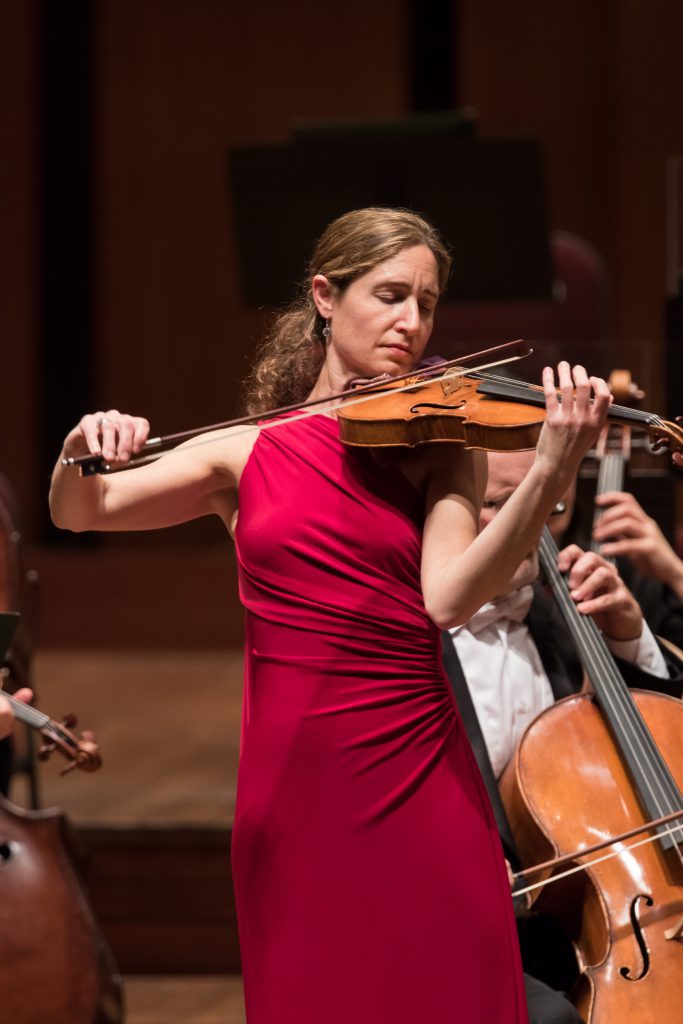Concertmaster Bar-Josef offers engaging Mozart with Eschenbach, NSO

Nurit Bar-Josef performed Mozart’s Violin Concerto No. 3 with Christoph Eschenbach and the National Symphony Orchestra Thursday night at the Kennedy Center. Photo: Scott Suchman
In his last season with the National Symphony Orchestra, Christoph Eschenbach continues to feature his principal musicians in concertos, a touching valedictory gesture. The latest was concertmaster Nurit Bar-Josef, who brought refinement and aptly scaled dazzle to Mozart’s Violin Concerto No. 3.
Mozart wrote this concerto when he was only 19, during the brief time he served as concertmaster of the Salzburg court orchestra. Eschenbach fielded a small ensemble of about thirty string players, which is still larger, by about a third, than the number Mozart would have had at Salzburg. Eschenbach compensated for this by reining in the sound of his musicians, yielding an elegant, contained backdrop for his soloist.
Bar-Josef reacted in kind, applying a rarefied, sunny tone to the happy opening theme of the first movement. She kept her prominent vibrato controlled for the most part, opening up into a more romantic idiom in the meditative cadenzas written by American violinist Sam Franko. The first was a zippy little scale up and down before the recapitulation, followed by a broader full cadenza at the end of the movement, with double-stops and other fireworks.
Mozart created an ethereal sound world in the second movement of this concerto, putting mutes on the strings and swapping out the two oboes for a pair of flutes. Eschenbach led the musicians in creating a distinct sound world, something like a “sommeil,” or magical sleep scene in a baroque opera. Bar-Josef could have modified her sound even more to match it, but she remained above it with a beautiful, fuller tone, especially in the long Franko cadenza.
Eschenbach’s brisk tempo made for a boisterous finale, with Bar-Josef serene and unhurried as her immaculate left hand flew over the rapid passages. Mozart ingeniously wove together both a happy folk-like tune, which gave the concerto its nickname (“Straßburg”), and a completely unrelated melodic section. One senses the violin virtuoso that Mozart might have been, but in the same year he wrote this piece, Salzburg’s court theater was shuttered, making the young composer, who most wanted to write operas, yearn even more to get out of his hometown.
Eschenbach paired this charming work with the less successful First Symphony of Bruckner, the sixth installment of his partial traversal of the Bruckner symphonies with the NSO. Bruckner premiered the work in 1868 in Linz, but even in the 1890/91 Vienna revision played here, edited in 1980 by Günther Brosche, the symphony feels half-formed. Some ingenious moments glimmer through, but the smaller brass section and Bruckner’s still maturing understanding of harmonic tension and orchestration mean that the “shiver” one typically experiences at some point in a Bruckner symphony never really blossoms.
This was the orchestra’s first performance of this version of the First Symphony. The tempo of the first movement was faster than warranted, making the bird-like flute part rather crazy, with some uncertainty in the trumpets and violins along the way. The second movement was slow, even deliberate, yet with some unpredictability in Eschenbach’s pacing. The symphony’s best moment is a section in this movement for three flutes over a tense timpani roll. The poor third flutist–who has to sit silent through a fifty-minute work for only this passage–was part of something quite beautiful, a typical Brucknerian excess.
Eschenbach started out quickly in the Scherzo, which Bruckner extended considerably in this revision, later settling into a better tempo. The dance feel of this movement especially is a reflection of the young Bruckner’s love of playing the violin for dancing. Most scholars view this symphony, which the composer referred to as “the bold young girl,” as more secular than sacred in orientation. The finale felt the most comfortable for both orchestra and conductor, with the two crescendos closest to producing that “Bruckner shiver,” at the midpoint and the conclusion.
The program will be repeated 8 p.m. Saturday. kennedy-center.org; 202-467-4600.









Posted Mar 17, 2017 at 5:06 pm by Laura Youens
Now I’m going to look up my recording of that Mozart concerto! (Like most people, I know #s 4 and 5 better.)